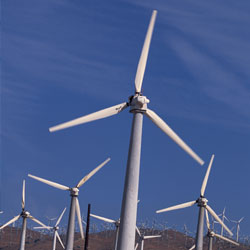 As the WINDPOWER 2011 Conference and Exhibition convenes in Anaheim, Calif., the wind industry finds itself at a bit of a crossroads. On one hand, wind energy has made great strides, such as its increased cost-competitiveness relative to other fuel sources. On the other hand, there are some major policy obstacles looming on the near horizon that could jeopardize its momentum.
As the WINDPOWER 2011 Conference and Exhibition convenes in Anaheim, Calif., the wind industry finds itself at a bit of a crossroads. On one hand, wind energy has made great strides, such as its increased cost-competitiveness relative to other fuel sources. On the other hand, there are some major policy obstacles looming on the near horizon that could jeopardize its momentum.
On the eve of WINDPOWER, NAW caught up with Peter Kelley, vice president for public affairs at the American Wind Energy Association (AWEA), who spoke about
wind energy's increased reliability and its reach.
The U.S. is a world leader in wind energy with 41,400 MW of installed capacity, Kelley says. In 2010, U.S. wind energy grew 15%, and generating capacity under construction at the start of the second quarter of 2011 is twice what it was in 2009 and 2010.
Further, he points to wind energy's increased cost-competitiveness.
According to power purchase agreements (PPAs) recorded at the Federal Energy Regulatory Commission, wind sold for between $0.034/kWh and $0.117 /kWh in 2009 and 2010, including many PPAs in the range of $0.05/kWh to $0.06/kWh.
‘Typically, wind energy is cheaper than new coal generation and cost-competitive with new natural gas in wind-rich areas, including tax incentives for all forms of energy generation,’ Kelley says.
Utilities are taking advantage of cost-competitiveness and locking in prices.
However, the question on the minds of conference attendees this year is the future of the production tax credit (PTC), which currently runs through 2012.
‘The current Congress should pass a long-term extension of the PTC to enable wind to continue to compete on a level playing field with 90 years of permanent incentives for other forms of energy,’ Kelley says, adding that extending the PTC is AWEA's top legislative priority.
The PTC, the primary incentive for wind energy over the years, has been a boon to wind energy development and proven to be essential to the industry's research and development. However, whenever the incentive has been allowed to lapse, wind development has followed suit.
According to AWEA, in 2003, 1,687 MW of capacity was installed in the U.S before a lapse of the PTC in 2004, when only 400 MW of capacity was installed. With the PTC reinstated in 2005, however, 2,431 MW of capacity was installed.
AWEA also supports extending master limited partnerships (MLPs) to wind energy.
According to John Marciano, an associate at the Washington, D.C., office of Chadbourne & Parke, an MLP is a partnership or limited liability company that trades units on a stock exchange. These large partnerships normally are taxed as corporations, but there are some exceptions that make them compelling for certain industries.
Marciano says one exception is for companies that receive virtually all of their income from natural-resource businesses. So-called natural resources generally are limited to gas, oil, fertilizer, geothermal and timber resources. Currently, wind and solar are excluded. However, there is a push to expand the eligible income sources to include renewables.
The MLPs that qualify for the exceptions are treated as transparent entities for tax purposes. This means that any depreciation, depletion or other tax incentive passes through to the investors. MLPs that grow through acquisitions typically have lots of tax write-offs that provide shelter against income taxes. The tax shield is "recaptured" at ordinary income tax rates later, when the investor sells his or her interest.
The combination of transparent tax treatment and public trading of units gives MLPs a much lower cost of equity capital than corporations with whom they might compete. The ability to use MLPs would expand the list of potential investors in wind projects.
Interestingly, the renewable electricity standard (RES)/clean energy standard (CES) debate, one of AWEA's top priorities in 2010, is getting less attention this year.
‘We want to make sure that any clean energy standard that Congress may take up deploys a diverse set of clean generation technologies at the lowest cost and doesn't preempt states' rights to design standards that surpass federal requirements,’ Kelley says.
‘However, I don't see an RES or a CES moving in the current political climate,’ he continues, adding that AWEA was not the only stakeholder frustrated by Congress' inability to pass such legislation. He says former Sen. Jeff Bingaman, D-N.M., recently remarked upon retirement that not seeing an RES pass was one of the senator's greatest regrets.



